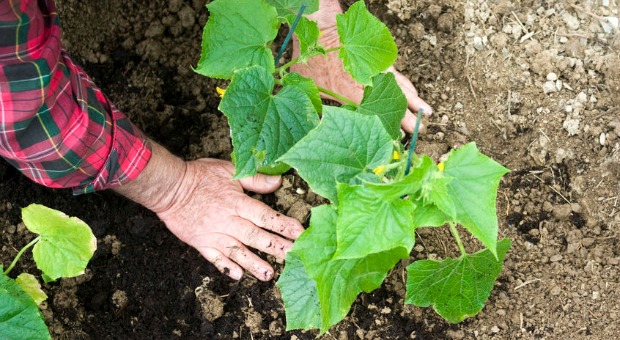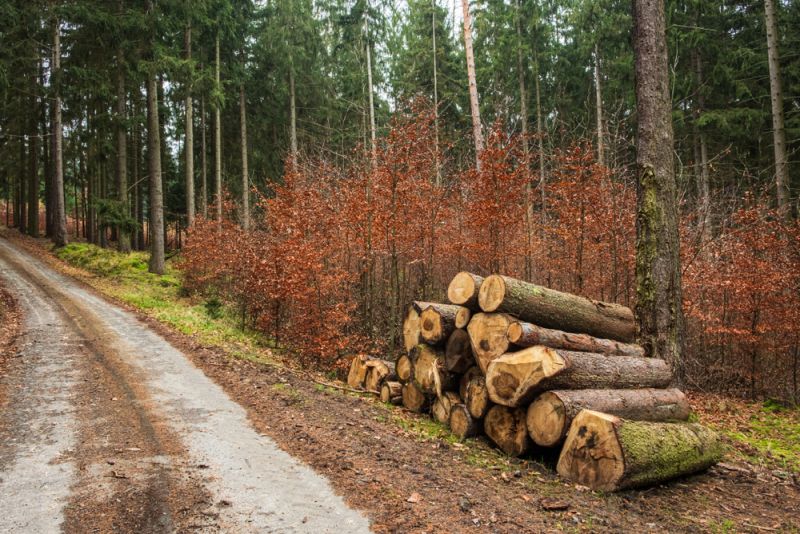Droughts are becoming more common. The impact of droughts on food production is very real. After all, plants need water to grow. But, you don’t always need a ton of water to grow food. That’s where low-water crops come in. They can produce food for your family to eat without taking nearly as much water.
If you don’t have a large water stockpile, or you are concerned about a coming drought, it might be time for you to switch to a low-water garden.
Low-water gardens are designed to receive significantly less water than a traditional one. The soil, coverings, and seeds are all meant to work together to minimize your water needs.
Also known as dry farming, this method is a return to the roots of agriculture for many locations. Before dams and irrigation innovations, farmers didn’t have the access to water. They planted, gave an initial soaking, and then let the plants tend to fetching water for themselves.
Winter is a great time to plan your low-water garden. But, no matter the season, here are some essentials to consider when working on this type of garden.
The Soil Is Essential
The quality of soil in your garden will help stretch the length of time between watering sessions. You’ll want plenty of compost and organic material in your soil.
This will help absorb water and slowly release it. You’ll also want some coarse sand in your soil. Sand helps draw in any moisture that does fall, so you’ll maximize the benefit of rain.
Clay is another component of low-water garden soil. The clay will hold the water, and slowly give it to the plants’ root systems.
You’ll want to thoroughly mix your soil, incorporating all the elements evenly. That way all your plants will grow well. Loose soil is recommended for this type of gardening, so tilling your soil to a depth of four to six inches will help.
Unfortunately, making the exact soil combination that you need for your climate will take time. There isn’t one perfect formula that’ll work everywhere.
Set up highly nutritious soil for your plants! Get your A to Z guide on survival gardening!
You Can’t Skip the Mulch
In a low-water garden, mulch isn’t just a suggestion. It’s essential. You need this soil covering to ensure the water stays where it belongs.
Without mulch, you’ll lose precious water to run-off. Evaporation will also be a problem.
A good layer of organic mulch prevents both of those from occurring. It’ll keep the water around the plants longer, and allow it to soak deeply into the soil.
What Plants to Choose
When picking plants, be sure to check out the hardiness zone recommendations so you don’t plant something that won’t grow well in your area. There are a variety of crops to pick from that don’t take as much water.
You can also have a long-term vision when creating a low-water garden. If you have plenty of water now, you can plant some perennials that will take water initially. Once those plants are established, their water needs drop substantially.
For both long and short term planning, here are some crops to consider:
Grains
If a drought happens, you won’t be able to depend on large grain producers to keep on growing. Even if you don’t regularly plant grains, you’ll want to have some low-water seeds stored on hand. That way you have them when you need them.
A bonus with these grains is they’re easier to harvest than wheat. Many take minimal processing before being ready to eat. These grains would be a good addition to your low-water garden crops:
- Amaranth
- Buckwheat
- Quinoa
- Field Corn
Vegetables
Vegetables are a great way to add variety and nutrients to your diet. Here are some excellent options for a low-water garden.
- Jerusalem artichoke (this takes more water the first year, but once it’s established it needs very little.)
- Sweet potatoes
- Swiss chard
- Peppers
- Asparagus (another long-term crop)
- Drought tolerant zucchini
Fruits
To add some natural sweetness to your diet, be sure to include some fruits in your low-water garden. Here are some plants that grow well with little water.
- Watermelon
- Figs
- Pomegranates
- Most pit fruit trees (once established)
- Rhubarb (once established)
Legumes
Many legumes don’t require much water. Consider adding these to your garden:
- Black eyed peas
- Chickpeas
- Tepary beans
Think Native
If you head to a natural area nearby, what plants are you going to see thriving? Chances are many of those are wild edibles. Take time to learn about plants native to your region.
Some of the plants considered weeds by many will be the perfect purposeful addition to your low-water garden. After all, no one is out in the woods irrigating the weeds. They just grow.
If you can’t find any seeds for these plants, try to dig up some established ones and transplant them. That way you’ll get a variety that grows well in your area.
You might even have a separate area where you encourage these plants to grow. That way they don’t take over your dedicated garden space. That will also help spread out your gardening efforts and minimize your risk of losing everything from theft. Hidden food sources are wonderful!
- Burdock
- Dandelions
- Lamb’s quarter
- Stinging nettles
- Plantain
Shopping for Seeds
When selecting varieties, you’ll want to go with heirloom seeds. Many modern versions of these plants have been altered and turned into very needy seeds. This is especially true with corn.
Back in the day, irrigation options were very limited. Plants often didn’t get much water unless it rained. You want plants that survived then—not the needy variations humans have turned those plants into.
The one exception would be plants that have been selectively bred for dry-land planting. You can often find drought-resistant varieties of many of your favorites.
Another tip is to plant mini-varieties of the plants you most want to grow. For instance, it takes much less water to grow a cherry tomato than it does a beefsteak. Planting a few of your favorite water-loving plants in the mini-form will help you keep from feeling deprived with your garden.
Save Your Seeds
By saving your own seeds each year, you’ll be selecting varieties that did the best in your soil. Over time, your seeds will be essential to increasing your yield. They are locally adapted plants that thrive in your garden.
Get your step-by-step instructions on how to plant over 125 plants inside your garden!
Companion Planting
The Native Americans knew much about growing food. One method they used is known as the three sisters. This method of companion planting grouped plants together to maximize their yield.
Corn, beans, and squash were the original three sisters. These crops work together in harmony. The beans give nitrogen to the soil, which the corn and squash need. The beans grow up on the tall corn stalks, reducing the need for additional scaffolding.
Finally, the low-lying squash leaves protect the soil from the sun’s rays and help ensure water doesn’t run-off.
Planting companion crops will also help you plant more in a smaller space. This is essential if you’re just getting your low-water garden established and don’t have much soil built up.
Give Plants Space
Because your dry land plants will need to establish a deep root system, you can’t plant individual plants or companion groupings as closely together as you do in a traditional garden. That means your yield won’t be the same.
When to Plant
Your soil needs to accumulate the winter moisture. This built-in reserve is what will get your plants through until harvest.
If you wait too long to plant, your soil will be too dry. Conversely, if you plant too early you risk a killing frost freezing your garden.
When you plant your seeds, you want the soil to be nice and moist. Keep an eye on both the weather and the soil. You’ll want to plant after the last killing frost, but before the daytime temperatures get so high that they dry up your soil.
Once planted, you need to seal in the moisture in the ground by applying a good layer of mulch. Have your mulch on hand and ready to go before you plant.
Caring for Your Low-Water Garden
Low-water gardens are easy to care for once they’re planted. You don’t want to water most of them, because you’ll risk cracking the dry soil. Cracked soil loses moisture much faster than soil that isn’t cracked.
Any watering that you do for your long-term plants that are just getting established needs to be done gently. You can’t turn a hose on full-blast. Rather, gently water the soil around the plant instead of the plant itself.
You don’t want to overwater any of the low-water varieties you are planting. Plants that don’t get watered will grow a deeper root system than ones that are frequently watered. You want to start your plants off trying to seek water from the ground.
Besides doing less watering, low-moisture gardens bring a couple of other benefits. They take much less time than a traditional garden.
For instance, you’ll notice that you won’t get as many weeds in a low-water situation once your plants are up. There just won’t be enough water for them to grow.
But, you’ll want to pluck out any weeds that do creep in. You’ll also want to be diligent about weeding as your plants are just sprouting. That way weeds aren’t competing with your plants for resources.
Many garden pests thrive in moist environments. They’ll often leave your dry land crops alone. So you’ll have fewer to deal with.
You might notice your plants starting to shrivel up before harvest. The leaves may turn brown and you might see spots. These are typical signs in a low-water garden, and they don’t necessarily mean you’re going to lose your harvest.
Are you a dry farmer?
What tips can you add to help others get started in this style of gardening? It’s a different approach to growing food, and everyone can benefit from you sharing your knowledge.
Start growing your survival garden that will keep you and your family fed for life!
This article has been written by Lisa Tanner for Survivopedia.











LeSellers | January 8, 2017
|
Rhubarb is not sweet! It’s not a fruit.
I love it, with stevia or another sweetener, but it’s almost inedible without.
ALAN RICHARDT | January 8, 2017
|
Careful of the wood chips/sawdust as they will tend to “strip” soils of nitrogen and leave you with far worse soils – need to put lightly spread fertilizer like matured chicken manure before using woochips/ sawdust. Actually, this comment applies to all mulches. Thick mulch is the most essential part of any garden – allows bugs and critters to add to fertilizer with their excrement and prevents water loss thru evaporation.
Larry Hicks | January 9, 2017
|
For the mountains of SW Virginia, what is recommended to conserve water in berry farms/apple,pear & peach orchard?
Pingback:4 Ways To Help Your Budget Survive Retirement | Survivopedia | September 18, 2017
|
Pingback:Bugging In: These Smart Water Solutions Will Save You | Survivopedia | October 19, 2017
|
Current Affairs 2018 | May 17, 2018
|
Many thanks sir, my utmost appreciation for the effort of your team, i am indeed a regular visitor to your articles , i thought to, (out of courtsey)
provide some suggestion and feedback of my own , would be
thankful if you could reply or recognize my suggestions to make
this website more content oriented .
Regards.
Rana Duggal.
Jane | July 5, 2018
|
Lovely article, Lisa! I love gardening infographics – I like to see everything I need as a information in one place, thanks!
Pingback:10 Wild Plants You Can Eat (+5 You Shouldn't!) | Survivopedia | July 17, 2018
|